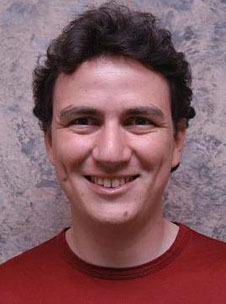POPULAR SCIENCE ANNOUNCES SEVENTH ANNUAL "BRILLIANT 10," TOP YOUNG SCIENTISTS POISED TO CHANGE THE WORLD
Byron SpiceTuesday, October 14, 2008Print this page.

The November issue of Popular Science magazine, on newsstands October 14, features PopSci's seventh annual "Brilliant 10," a list of the country's top young scientists to watch.
"The Brilliant 10 are the brightest researchers of 2008, making the breakthroughs of tomorrow," says Mark Jannot, editor in chief of Popular Science. "PopSci is paying homage to these young scientists, who explore the world with an altogether original eye."
ThePopular ScienceBrilliant 10 are:
THE INFORMATION WRANGLER: Carlos Guestrin, 33
Carnegie Mellon University- Computer Science
Guestrin has developed a single algorithm that can get the mostinformation with the least amount of effort. In gathering information,he devised a way to optimize both the location and the number ofsensors to gather the highest-quality data. There are other sensoralgorithms, but Guestrin's is uniquely fast and accurate.
THE NEURAL PUPPETEER: Karl Deisseroth, 36
Stanford University- Neurophysics
Deisseroth developed a way to plug straight into the brain to map ourthoughts, neuron by neuron. The secret is a class of light-sensitiveproteins called channelrhodopsins that occur naturally in algae. Whenexposed to light, the proteins help regulate the flow of sodium into acell, which determines whether or not a neuron fires. Deisseroth hasdevised a way to activate and deactivate the neurons as easily asflipping a switch.
THE DRUG PUMPER: John Santini, 36
Founder and CEO of MicroCHIPS
Santini was diagnosed with lupus during childhood and was told he'dhave to take medication indefinitely. This inspired him to buildunder-the-skin chips that deliver drugs straight into the blood. Hefounded MicroCHIPS, which builds electronic devices that are implantedunder the skin. These "chips" sense changes in body chemistry ordeliver medications when needed.
THE INFANT'S PHILOSOPHER: Rebecca Saxe, 29
Massachusetts Institute of Technology- Social Neuroscience
By studying babies' behavior and eye movements, thisphilosopher-turned-scientist wants to answer the big questions inneuroscience: How does the brain deal with the information coming infrom the eyes and the ears? How does it turn that information intothoughts that we then act on? Saxe is starting to answer thosequestions by investigating one specific case: How do we come to knowthe thoughts of others? She ended a decades-long argument amongneuroscientists when she showed that there is a specific part of ourbrains dedicated to thinking about others' desires.
THE JELLYFISH ENGINEER: John Dabiri, 28
California Institute of Technology- Biomechanics
This biomechanics professor and his students record the motions ofjellyfish with a custom-built, high-definition video camera and awater-particle-illuminating laser. The measurements will be fed intosoftware programs that reveal the intricacies of how jellyfish push offtheir own wake and thus use less energy to propel themselves forward.Already, Dabiri's findings are inspiring design improvements indata-collecting buoys, military submarines, even onshore windmills.
THE BOND BREAKER: Melanie Sanford, 33
University of Michigan- Organic Chemistry
To build drugs, chemists start with a base molecule, then add andsubtract atoms from it one by one in a sequence of reactions. Theprocess is tedious and wasteful, and a chemist might not even be ableto make the drug. In her Ann Arbor, Michigan, lab, Sanford hasengineered a novel solution. She's learned how to transform one of themost basic chemical connections, the carbon-hydrogen bond. Thediscovery has opened up entirely new approaches to molecule-building,which could make new drugs possible.
THE ATOMIC VISIONARY: Ali Yazdani, 40
Princeton University- Superconductivity
Yazdani began his career as a teenage Iranian television repairman, butafter he emigrated to the U.S., a course in quantum mechanics pulledhim into science. Recently, he's overturned the accepted thinking onhigh-temperature superconductors with a desk-size scanning-tunnelingmicroscope. It can cool a sample to just above absolute zero, seal itin a near-perfect vacuum, and block the faintest noises. As a result,he can continuously track single atoms for months at a time.
THE TURTLE TRAINER: T. Todd Jones, 33
University of British Columbia- Conservation Biology
The endangered leatherback sea turtle has rarely been seen alive,because after birth and nesting, they simply scurry off into the ocean,swimming thousands of miles from ocean to ocean. Enter Jones, whosebackground in both animal physiology and conservation issues provided auseful nexus of expertise and perspective. He designed a JollyJumper-like harness that suspends the leatherbacks so they cancontinuously swim and dive without touching anything. To simulate theturtles' natural diet of jellyfish, for example, he created asubstitute dubbed "squid Jell-O," which is hand-fed to the leatherbacks.
THE MATERIALIST: Francesco Stellacci, 35
Massachusetts Institute of Technology- Nanotechnology
Earlier this year, Stellacci announced that his group had developed amaterial that can suck 20 times its weight in oil out of a sample ofwater. The material can be used to clean up massive crude-oil spills,and some have called the work a blueprint for scientists designingnanomaterials to help protect the environment. Yet Stellacci doesn'tconsider this his best work. He's excited about tricking cells anddesigning nanomaterials with outrageous abilities.
THE BODY BUILDER: Kristi Anseth, 40
University of Colorado- Tissue Engineer
As a Ph.D. student at the University of Colorado, Anseth built advancedmaterials for semiconductors. But the chemical engineer's past-her auntdied during childbirth from a heart defect, and her father died from ananeurysm-would draw her away from microchips to the body. She developedhydrogels, a class of materials that look and feel like gelatin, onlythey trigger rapid healing in human tissue. The most promisingapplication is in helping repair injured knee cartilage; Anseth expectsFDA approval in 5 to 10 years. Her work doesn't stop with knees,though. She's created hydrogels to help regenerate defective heartvalves, mend shattered bones, produce insulin for diabetics, and growhealthy neurons to replace diseased brain tissue.
For more information on PopSci's Brilliant 10, contact Kendra Romagnola at 212-779-5172 or kendra.romagnola@bonniercorp.com.
Byron Spice | 412-268-9068 | bspice@cs.cmu.edu
